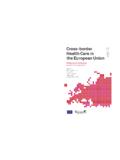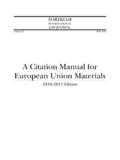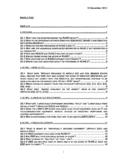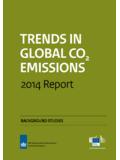Transcription of Aurore Nicol, Julie Caruso, & Éric Archambault Open …
1 Aurore Nicol, Julie Caruso, & ric Archambault Open Data Access policies and strategies in the european research Area and Beyond August 2013 Aurore Nicol, Julie Caruso, & ric Archambault Open Data Access policies and strategies in the european research Area and Beyond August 2013 Produced for theEuropean Commission DG research & InnovationRTD-B6-PP-2011-2: Study to develop a set of indicators to measure open access The views expressed in this report are those of the authors and do not necessarily represent the views of the european Commission by Science-Metrix | Montreal | Washington1335 Mont-Royal E.
2 , Montr al Qu bec, Canada, H2J 1Y6 image: iStockphoto Open Data Access policies and strategies August 2013 i Produced for the european Commission DG research & Innovation Executive Summary This report examines policies and strategies towards open access (OA) of scientific data in the european research Area (ERA), Brazil, Canada, Japan and the US from 2000 onwards. The analysis examines strategies that aim to foster OA scientific data such as the types of incentives given at the researcher and institutional levels and the level of compliance by researchers and funded organisations and also examines how, and whether, these policies are monitored and enforced.
3 The infrastructures developed to store and share OA scientific data are also examined. The analysis is supported by findings from the literature on the global progression of OA scientific data since 2000 including its growth as a segment of scholarly publishing as well as some of the broader trends, themes and debates that have emerged from the movement. Governmental OA Scientific Data strategies Governments produce and own large datasets. To date, most national open data policies primarily target these datasets which are not necessarily generated through scientific research but may be used for research rather than scientific data at large.
4 The importance of comprehensive OA policies was recognised in 2004 by the Ministers of Science and Technology of the then 30 OECD countries, and of China, Israel, Russia, and South Africa. Governments may reap important economic benefits from the release of OA scientific data, such as through economic growth and job creation deriving from innovation, and through better informed policy and research . It has been estimated that, by unlocking the potential of big data, developed european economies could save between 150 billion and 300 billion annually in the form of operational efficiency gains and increased potential versus actual collection of tax revenue alone.
5 A study has estimated the value of direct and indirect economic impacts of government-owned data across the EU-27 at 140 billion annually. It also estimated that, with lower barriers and improved infrastructure, this value could have been around 200 billion in 2008, representing of the european GDP for that year. In order to unlock the full economic potential of OA scientific data, machines must be able to access and mine this information without copyright infringement.
6 The european Commission s Working Group on Text and Data Mining (TDM) Licences for Europe initiative has addressed this challenge through stakeholder dialogue. However, representatives from groups of researchers, science organisations, libraries, and small and medium enterprises have withdrawn from the process, arguing that the Working Group s decision to place licensing at the centre of discussions constitutes a bias against other solutions to adapt the legal framework to TDM applications. The european Union issued a directive on the re-use of public sector information as early as 2003, while the US government was the first to establish its own open data portal, , in 2009.
7 National public data repositories were launched in the succeeding years in 20 countries (Austria, Belgium, Brazil, Canada, Denmark, Estonia, Finland, France, Germany, Greece, Ireland, Italy, Japan, the Netherlands, Norway, Portugal, Slovakia, Spain, Sweden and the United Kingdom). Major international organisations have also launched open data portals, including the United Nations, OECD, european Commission, International Energy Agency (IEA), Nuclear Energy Agency (NEA), Programme for International Student Assessment (PISA), and International Transport Forum (ITF).
8 The World Bank s repository, , launched in 2011, is a landmark repository in terms of its usability by machines and humans alike. The bulk of currently available open governmental data repositories belong to states, provinces, and municipalities. However, a few national, which in many cases have taken international Open Data Access policies and strategies August 2013 ii Produced for the european Commission DG research & Innovation proportions, now offer access to vast amounts of data. Notable governmental/funding bodies initiated OA scientific databases include the NIH s GenBank, the DNA DataBank of Japan (DDBJ), and the european Molecular Biology Laboratory (EMBL) Nucleotide Sequence Database, and the database.
9 Funding Bodies strategies Funding bodies may have an interest in archiving and disseminating data generated by their grantees to monitor the outcomes of their investments, increase the visibility of their contribution to research , and ensure long-term preservation of the data. Mining and further analysing the data collected from multiple projects could also highlight underrepresented or emerging areas of interest. Funding bodies have far fewer OA policies for scientific data than policies for scientific publications.
10 In an analysis conducted by Science-Metrix of 48 funders OA policies listed in ROARMAP within ERA countries, Brazil, Canada, and the US, 23% explicitly excluded data from OA requirements and 38% did not mention data at all. Conversely, 29% of policies mandated open data archiving and 10% encouraged it without mandating it. Although some rare funding bodies operate their own repositories, most recommend the use of institutional, disciplinary, or aggregating repositories. Institutions, governmental bodies, and research networks may be better able to define their needs in terms of standards, space, and functionality based on a more direct relationship with the researchers who produce the data or with the users of the data.








